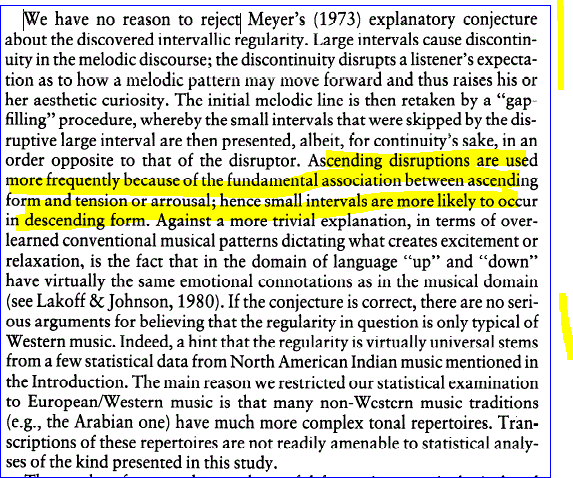|
Ricardo -> RE: Descending scale runs (Feb. 22 2024 12:15:40)
|
The truth is that it is not about intervals. It is about how melodies were historically constructed. Ascending is the away direction of a mode or key that the song is based on…that is AWAY from the finalis or tonic note. Modes in the Renaissance, based on plain chants, were numbered 1,3,5,7, based on D,E, F, or G tonics or finals. The even modes expand the tessitura to intervals of the main melody that will occur BELOW the tonic note, so you would in theory have more ascending melodic things in modes 2,4,6, or 8. But in practice melodies are all over the place and don’t necessarily conform to any rules, especially as ficta are added (any accidentals other then Bb).
So the descending thing is super duper important to all the modes or keys that melodies are based on, because the descending portion 3,2,1 is essential for the cadences. That means ALL MELODIES will inevitable descend like that to come to a conclusion. So think of the famous “Andalusian cadence” not as a chord thing, but rather, a melody thing based on mode 3…the melody AGFE is the descending vocal cadence of the mode. A counter voice above that melody would be like F-C-D-E, moving opposite. That is how you get the chords F-C-Dm/F-E that we use in Soleá for example. But when we do picado, the scale would reflect the vocal dominant descending melody.
These picado runs can be seen in the renaissance Lute and vihuela tabs and they are relexions of the vocal melodies (sometimes literal intabulations of vocal pieces). Pretty much ALL the cantes of flamenco conclude with some descending scale, so picado is based on the primary melodies of all times historically. After the Renaissance and modes 1-4 collapse to minor key, and modes 5-8 collapse into major keys (common practice period), the counter voice type melodies of vocal polyphony start to be used as part of primary or main melody constructions as well. But for sure the practical thing about descending scale for both voice and guitar, is the release of tension, the vocal chords lose tension on the way down, and for guitar players, our technique of attacking strings from below make descending scales more natural than ascending ones (as revealed when we cross strings). But the musical cadences evolved from these descending melodies and that is the main thing.
|
|
|
|

